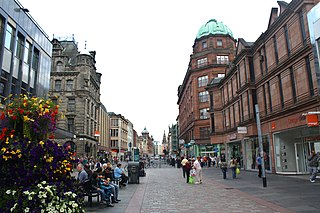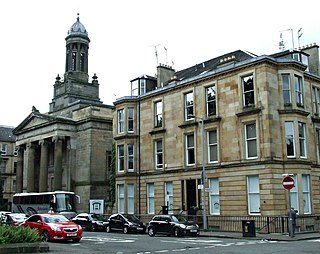
Buchanan Street is one of the main shopping thoroughfares in Glasgow, the largest city in Scotland. It forms the central stretch of Glasgow's famous shopping district with a generally more upmarket range of shops than the neighbouring streets: Argyle Street, and Sauchiehall Street.
Woodlands is an area of Glasgow, Scotland. Situated on the north-west edge of the city centre, Woodlands is located within Glasgow's fashionable West End, east of Hillhead, south of Woodside, north of the Park District and Kelvingrove Park, and west of Charing Cross and Garnethill.
Garnethill is a predominantly residential area of the city of Glasgow, Scotland with a number of important public buildings.

The McLellan Galleries are a major exhibition space in the city of Glasgow, Scotland, situated behind a frontage of shops and offices in Sauchiehall Street.

Madeleine Hamilton Smith was a 19th-century Glasgow socialite who was the accused in a sensational murder trial in Scotland in 1857.
The Sandyford murder case is a well-known 19th-century case from the United Kingdom. The murder in question is one of four notorious ones that took place in an infamous area of Glasgow known as the Square Mile of Murder, which lies around Charing Cross, "situated where Sauchiehall Street is coming to an end as a shopping centre and giving way to well-built terraces". The Sandyford case revolves around the brutal murder of one Jessie McPherson, a servant, at 17 Sandyford Place, Glasgow, Scotland, in July 1862. McPherson's friend Jessie McLachlan later stood trial, accused of having murdered McPherson.
Blythswood Hill, crowned by Blythswood Square, is an area of central Glasgow, Scotland. Its grid of streets extend from the length of the west side of Buchanan Street to Gordon Street and Bothwell Street, and to Charing Cross, Sauchiehall Street and Garnethill. Developed from 1800 onwards, its Georgian and Victorian architecture is a Conservation Area. It started as the "Magnificent New Town of Blythswood", becoming a part of the city-centre's business and social life.

Sauchiehall Street is one of the main shopping streets in the city centre of Glasgow, Scotland, along with Buchanan Street and Argyle Street.

The Willow Tearooms are tearooms at 217 Sauchiehall Street, Glasgow, Scotland, designed by internationally renowned architect Charles Rennie Mackintosh, which opened for business in October 1903. They quickly gained enormous popularity, and are the most famous of the many Glasgow tearooms that opened in the late 19th and early 20th century. The building was fully restored, largely to Mackintosh's original designs, between 2014 and 2018. It was re-opened as working tearooms in July 2018 and trades under the name "Mackintosh at The Willow". This follows a trademark dispute with the former operator of The Willow Tearooms which was resolved in 2017. That name is now used at tearoom premises in Buchanan Street and was additionally used at the Watt Brothers Department Store in Sauchiehall Street, Glasgow between 2016 and its closure in 2019.

Charing Cross is a major road junction and area within the centre of Glasgow, Scotland. It is situated north of the River Clyde at the intersection of Sauchiehall Street, St George's Road, Woodlands Road, North Street and Newton Street, as well as being at a major interchange of the M8 motorway. Charing Cross marks the notional boundary between the City Centre and the West End of the city.

Edward William Pritchard was an English doctor who was convicted of murdering his wife and mother-in-law by poisoning them. He was also suspected of murdering a servant girl, but was never tried for this crime.

William Harley (1767–1830) was a Scottish textile manufacturer and entrepreneur who is known for his early contributions to the city of Glasgow, including the development of the New Town of Blythswood, covering Blythswood Hill, and pioneering hygienic dairy farming.

Argyle Street is a major thoroughfare in the city centre of Glasgow, Scotland.
Glasgow City Centre is the central business district of Glasgow, Scotland. It is bordered by the Saltmarket, High Street and Castle Street to the east, the River Clyde to the south, and the M8 motorway to the west and north. It is made up of the areas of Garnethill, Blythswood Hill, and Merchant City, though parts of Cowcaddens, Townhead, Anderston and Calton also fall within its boundaries.

St. Vincent Street, is one of the major streets in the city centre of Glasgow, Scotland. It was formed in the early 1800s as part of the residential New Town of Blythswood developed by William Harley of Blythswood Square. St. Vincent Street was named to commemorate the victory of Sir John Jervis, on 15 February 1797, off Cape Saint Vincent, Portugal. when the Royal Navy defeated the Spanish fleet which was on its way to join Napoleon's French fleet. The first part of the street, from George Square to Buchanan St, containing numbers up to 41, is named St Vincent Place.

Blythswood Square is the Georgian square on Blythswood Hill in the heart of the City of Glasgow, Scotland. The square is part of the 'Magnificent New Town of Blythswood' built in the 1800s on the rising empty ground west of a very new Buchanan Street. These open grounds were part of the vast Lands of Blythswood stretching to the River Kelvin acquired by the Douglas-Campbell family in the 17th century. The Blythswood district, and its grid of streets, became a Conservation Area in 1970, because of its important architectural and historic buildings.

Kelvingrove is a neighbourhood in the city of Glasgow, Scotland. It is situated north of the River Clyde in the West End of the city, and directly borders Kelvingrove Park to the north and the grounds of the Kelvingrove Art Gallery and Museum to the west. Its other boundaries are not precisely defined, but roughly correspond to Sauchiehall Street to the south opposite the Sandyford neighbourhood, and the Charing Cross area to the east.

Sandyford is an area of Glasgow, Scotland. It is north of the River Clyde and forms part of the western periphery of the city centre. Formerly the name of a ward under Glasgow Town Council in the first part of the 20th century, it is within a continuous area of fairly dense urban development bordering several other neighbourhoods whose mutual boundaries have blurred over time, and is possibly less well known than all of the places which adjoin it, particularly Anderston and Finnieston.

James Smith (1808–1863) was a 19th-century Scottish architect who specialised in very large country mansions.
Gertrude Annie Lauder was an English-born Scottish painter, born in Camden Town, England. She moved to Glasgow, Scotland: where she joined the Glasgow Society of Lady Artists; married the artist Charles James Lauder; and exhibited in the Royal Scottish Academy. On her death she left legacies to the Scottish Artists Benevolent Association, gave a fund to the Glasgow Art Club and left a fund to the Glasgow Society of Lady Artists to encourage art by women. The Lauder Prize, named for the best work adjudged in the Glasgow Society of Lady Artists annual exhibition, is named after her.














